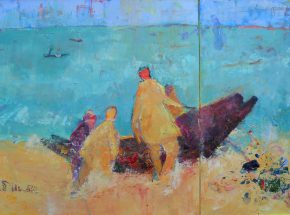

“Navajo Weaving is my Life”
By Sarah H. Natani
My clan is Hooghanlani and my father’s clan is Nakai Dine. My grandfather’s clan is Ta’ neeszahnii and my Nali’s clan is Hozae Tachii’nii. I was raised in Littewater and Table Mesa, New Mexico, U.S.A.. My name is Sarah H. Natani. I grew up with my four sisters and three brothers. At that time, sheepherding was our main life everyday. We always had sheep and goats. We also had a farm, which my father, Nakai Chee use to plant squash, corn and melons. We had different sheep camp areas where we would move to depending on the season. We had a summer camp, spring camp and a fall camp.
My father, Nakai Chee also had an English name: Willeon Bitsoi, but the community called him Nakai Chee because his complexion was reddish brown. My mother, Mary Lee Henderson was married to him. He was much older than her. My mother had the knowledge of making Navajo Pottery, Moccasin making, making red powder (chii) and weavings. She was also known in the community for making the Navajo “paper bread” which is called “tse its steah”.
It was Nakai Chee, my father who encouraged me to learn how to weave. At that time the sheep wool was like a commodity where we were cautious how we use the wool. We, as children were not allowed to waste the wool. Also, at that time in Littlewater there were oil companies working around our homes. The oil workers threw their old Levi denim pants away and those denim pants were cut into strips for me to weave. My loom was set outside of the Hogan on the South side, where it was warm. That is the place I first learn how to weave. After my first weaving, I began to weave the simple stripes and I would help my mother with the finishing edge. Than I saw a different type of weaving that caught my attention. It was a saddle twill weaving. I studied the weaving and with the encouragement of my father I begin to learn how to twill weave. He told me, that twill weaving is a weaving that has feelings of “selfishness”. He told me that twill weavings either accept you to learn or it will reject you to learn. So, I begin to teach myself how to weave twill. I had to learn how to count the warp in different shed counts to get the different designs. My father gave me a twill weaving to study the warp count. I studied this weaving by examining closely the warp count. From that experience I begin to learn how to weave twill weavings. Today, I know about 25 different twill-weaving designs and I am very proud to say that I am self-taught.
In 1972, I went to my first Hand Weavers Guild of America Convergence held in San Francisco, CA. I saw many different ways to spin wool and weave. At that time I was amazed to see the European Spinning Wheel. The spinning wheel spun the wool so fast. I also saw how the drop spindle and the Turkish spindle spun wool. I meant so many different people working with wool in different ways. Attending my first Weaving Convergence made me so exited to learn more about hand spinning and weaving. That is also when I meant my long time dear friend, Mary Black. It was through Mary, that I received my first Spinning Wheel. Her friendship inspired me to continue with the fiber arts and to this day we continue to share ideas and creative arts.
Our Navajo weaving has helped me to be strong throughout my life. When my late husband, Leo Natani got into an automobile accident he was not able to work for a period of time. I went to the Welfare office and they told me that I didn’t qualify for help because I owned a “livestock-grazing permit”. They told me to sell the grazing permit. I was surprised and didn’t know what to do, so I went to my mother, Mary Lee Henderson. I told her what the welfare people told me. That is when she told me, “shi yazhi (my child), in each of your fingers, you have everything that you need to provide for your family. These staples are practically dripping off your fingers like water. You have the foods that will feed your family, the clothes for your children, the transportation needed for your family, the sheep that will help you, all the different knowledge’s to help you. Utilize your “gifts” and you will be able to provide for your family and don’t sell the “grazing permit.” So from that day on I begin to spin wool and my Navajo weaving began to have a heart beat. That was about 49 years ago.
Around 1975, my mother gave me about 20 sheep and that is when my family begin to raise sheep. The kids learn how to herd sheep and weave. My late husband and I managed about 250 sheep at one time. That time there was still a lot of grass to herd sheep everyday. Than around the year 2000 we told our kids that they had to start caring for the sheep and cattle. Today, we still have cattle and our sheep. We also still take our sheep to the summer sheep camp in the Chuska Mountains. I am very proud of the kids for their dedication to continue to have sheep and cattle. It is a hard job but it is also a special job that connects us back with how our grandparents lived. I am also very proud of my family to continue with the weaving. My daughters and grand-daughter are active weavers and my son and grand-sons make the weaving tools. The tradition of weaving is continuing in my family and that makes me proud.
Navajo weaving has given me great opportunities to work with the communities and to travel beyond Navajo land. I use to teach weaving at the Bureau of Indian Affairs, Adult Education and at the Dine College in Shiprock. With our Navajo weaving, I have been able to travel throughout China, Italy and the United States. When I see how other nationalities weave, that inspires me to learn more about weaving in general. There is much still to be learned, especially with our own twill weavings.
Navajo weaving is like a family. When you meet another weaver, no matter where they are from, you have a common connection. That is the special energy, the special magic that keeps me going. I encourage all of you to learn how to herd sheep, card wool, spin wool, learn about plant dyes and learn about our weaving. There are many books nowadays to learn from. But the best teacher lives in you. If you teach yourself these different knowledge, you will learn to be strong and it will be good for you. Learn these different weaving knowledge’s for yourself first, than teach your children, and teach them to teach your grandchildren. When they learn these weavings than they will not say “my grandparents knew how to weave but I didn’t learn”. Keeping your mind active is also good for you. Everyone must learn how to be self-sufficient and look at your hands. Each of your fingers has the gifts that you need to provide for yourself and your family.

